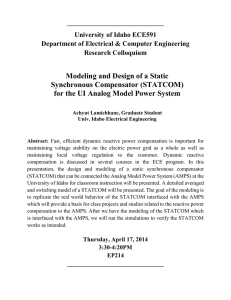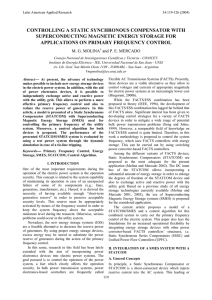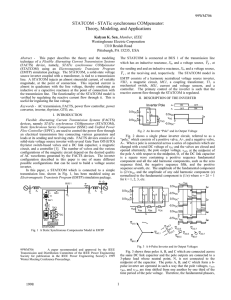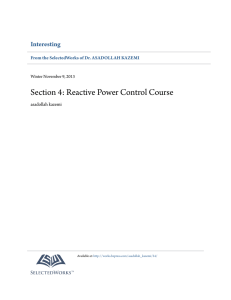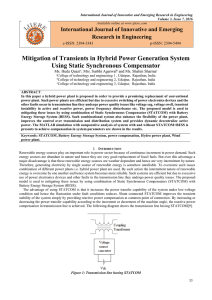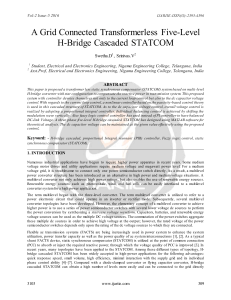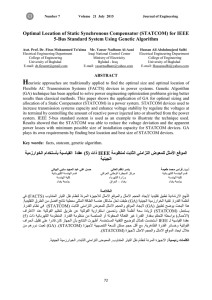Reactive Power Compensation by Using Static Synchronous
advertisement
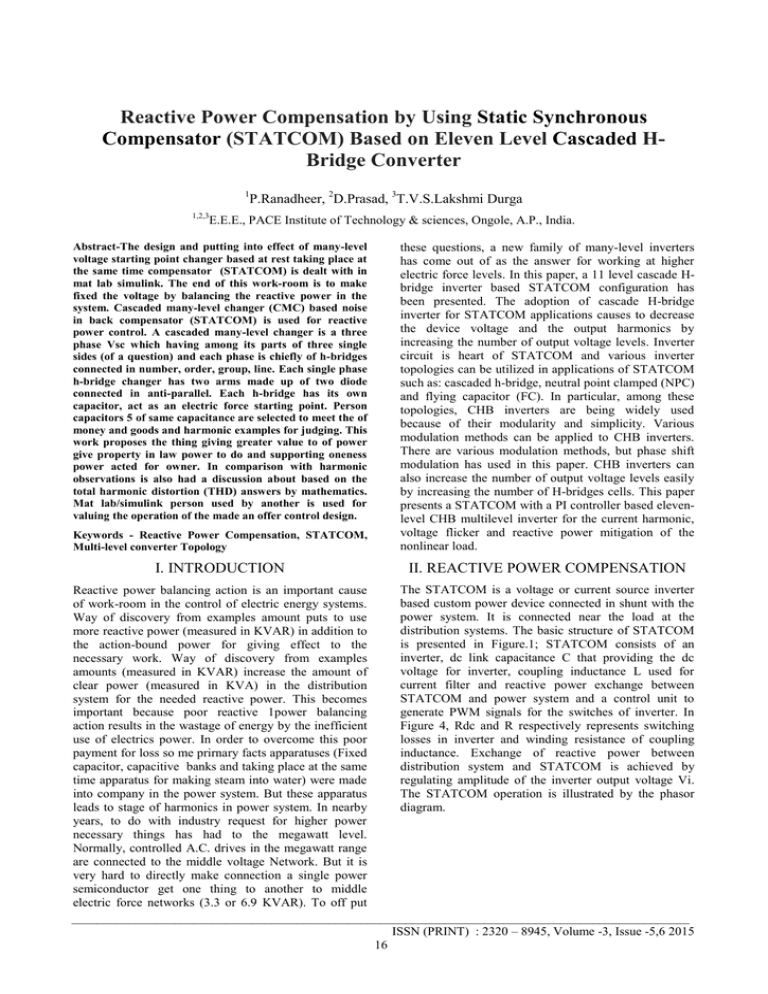
ITSI Transactions on Electrical and Electronics Engineering (ITSI-TEEE) ________________________________________________________________________________________________ Reactive Power Compensation by Using Static Synchronous Compensator (STATCOM) Based on Eleven Level Cascaded HBridge Converter 1 1,2,3 P.Ranadheer, 2D.Prasad, 3T.V.S.Lakshmi Durga E.E.E., PACE Institute of Technology & sciences, Ongole, A.P., India. Keywords - Reactive Power Compensation, STATCOM, Multi-level converter Topology these questions, a new family of many-level inverters has come out of as the answer for working at higher electric force levels. In this paper, a 11 level cascade Hbridge inverter based STATCOM configuration has been presented. The adoption of cascade H-bridge inverter for STATCOM applications causes to decrease the device voltage and the output harmonics by increasing the number of output voltage levels. Inverter circuit is heart of STATCOM and various inverter topologies can be utilized in applications of STATCOM such as: cascaded h-bridge, neutral point clamped (NPC) and flying capacitor (FC). In particular, among these topologies, CHB inverters are being widely used because of their modularity and simplicity. Various modulation methods can be applied to CHB inverters. There are various modulation methods, but phase shift modulation has used in this paper. CHB inverters can also increase the number of output voltage levels easily by increasing the number of H-bridges cells. This paper presents a STATCOM with a PI controller based elevenlevel CHB multilevel inverter for the current harmonic, voltage flicker and reactive power mitigation of the nonlinear load. I. INTRODUCTION II. REACTIVE POWER COMPENSATION Abstract-The design and putting into effect of many-level voltage starting point changer based at rest taking place at the same time compensator (STATCOM) is dealt with in mat lab simulink. The end of this work-room is to make fixed the voltage by balancing the reactive power in the system. Cascaded many-level changer (CMC) based noise in back compensator (STATCOM) is used for reactive power control. A cascaded many-level changer is a three phase Vsc which having among its parts of three single sides (of a question) and each phase is chiefly of h-bridges connected in number, order, group, line. Each single phase h-bridge changer has two arms made up of two diode connected in anti-parallel. Each h-bridge has its own capacitor, act as an electric force starting point. Person capacitors 5 of same capacitance are selected to meet the of money and goods and harmonic examples for judging. This work proposes the thing giving greater value to of power give property in law power to do and supporting oneness power acted for owner. In comparison with harmonic observations is also had a discussion about based on the total harmonic distortion (THD) answers by mathematics. Mat lab/simulink person used by another is used for valuing the operation of the made an offer control design. The STATCOM is a voltage or current source inverter Reactive power balancing action is an important cause based custom power device connected in shunt with the of work-room in the control of electric energy systems. power system. It is connected near the load at the Way of discovery from examples amount puts to use distribution systems. The basic structure of STATCOM more reactive power (measured in KVAR) in addition to is presented in Figure.1; STATCOM consists of an the action-bound power for giving effect to the inverter, dc link capacitance C that providing the dc necessary work. Way of discovery from examples voltage for inverter, coupling inductance L used for amounts (measured in KVAR) increase the amount of current filter and reactive power exchange between clear power (measured in KVA) in the distribution STATCOM and power system and a control unit to system for the needed reactive power. This becomes generate PWM signals for the switches of inverter. In important because poor reactive 1power balancing Figure 4, Rdc and R respectively represents switching action results in the wastage of energy by the inefficient losses in inverter and winding resistance of coupling use of electrics power. In order to overcome this poor inductance. Exchange of reactive power between payment for loss so me prirnary facts apparatuses (Fixed distribution system and STATCOM is achieved by capacitor, capacitive banks and taking place at the same regulating amplitude of the inverter output voltage Vi. time apparatus for making steam into water) were made The STATCOM operation is illustrated by the phasor into company in the power system. But these apparatus diagram. leads to stage of harmonics in power system. In nearby years, to do with industry request for higher power necessary things has had to the megawatt level. Normally, controlled A.C. drives in the megawatt range are connected to the middle voltage Network. But it is very hard to directly make connection a single power semiconductor get one thing to another to middle electric force networks (3.3 or 6.9 KVAR). To off put ________________________________________________________________________________________________ ISSN (PRINT) : 2320 – 8945, Volume -3, Issue -5,6 2015 16 ITSI Transactions on Electrical and Electronics Engineering (ITSI-TEEE) ________________________________________________________________________________________________ III. SIMULATION RESULTS Fig.1 Configuration of a Static Synchronous Compensator (STATCOM) Fig.3 Proposed SIMULINK circuit without Static Synchronous Compensator (STATCOM) Fig.2 Circuit Diagram of the Single Cascaded H-Bridge converter Fig.4 Proposed SIMULINK circuit with Static Synchronous Compensator (STATCOM) simulation results Fig.5 Eleven level output voltage Single-phase structure of a multilevel cascaded Hbridges inverter As a result, the Static Synchronous Compensator (STATCOM) output voltage can be controlled by the Modulating Index (MI). STATCOM is proportional to MI, as long as the individual inverter is in the linear modulating region. Due to its ability to control the output voltage by the modulating index, the proposed ST A TCOM has extreme fast dynamic response to system reactive power demand. Fig.6 Total Harmonic Distortion (THD) of output voltage ________________________________________________________________________________________________ ISSN (PRINT) : 2320 – 8945, Volume -3, Issue -5,6 2015 17 ITSI Transactions on Electrical and Electronics Engineering (ITSI-TEEE) ________________________________________________________________________________________________ compensate the reactive power and reduce the harmonics in output of STATCOM. REFERENCES Fig.7 Three phase voltage & current without Static Synchronous Compensator (STATCOM) Fig.8 Three phase voltage & current with STATCOM [1] Aurelio Garcia Cerrada, (2000) "Comparison of Thyristor-Controlled Reactors and Voltage Source Inverters for Compensation of Flicker Caused by Arc Furnaces" IEEE Transaction on Power Delivery, Vol. 15, No.15, pp: 1225-1231, October. [2] Cee, Josep, (2003) "Circuit-Level Comparison of ST A TCOM Technologies" IEEE Transaction on Power Electronics, Vol. 18, No.4, pp: 1081-1092, July. [3] Chong Han, Zhanoning Yang, (2007)"Evaluation of Cascade Multilevel Converter Based ST ATCOM for Arc Furnace Flicker Mitigation" IEEE Transaction on Industry Applications, Vol. 43, No.2, pp: 378-385, March! April. [4] Hirofumi Akagi (2011) "Classification, Terminology, and Application of the Modular Multilevel Cascade Converter (MMCC)" IEEE Transaction on Power Electronics, Vol. 26, No.11, pp: 3119-3130, August. [5] Jon Andoni Barrena (2008) "Individual Voltage Balancing Strategy for PWM Cascaded H-Bridge Converter Based STATCOM" IEEE Transaction on Industrial Electronics, Vol. 55,No. 1, pp: 2130, January. [6] Makoto Hagiwara (2008) "Control and Experiment of Pulse width Modulated Modular Multilevel Converter" IEEE Transactions on Power Electronics, Vol. 24, No.7, pp: 1737-1746, October. IV. CONCLUSION This proposed work gives the solution of reactive power compensation in the field of transmission lines, industries, as well as generating stations. The cascaded controller is designed for eleven levels CMC based STATCOM. These control schemes regulates the capacitor voltage of the STATCOM and maintain rated supply voltage for any load variation within the rated value. It has been shown that the CMC is able to reduce the THD values of output voltage and current effectively. The CMC based ST A TCOM ensures that ________________________________________________________________________________________________ ISSN (PRINT) : 2320 – 8945, Volume -3, Issue -5,6 2015 18
